The concept of magnetic field
We all know what permanent magnets are. Magnets are metal bodies attracted to other magnets and some metals. What is located around the magnet and interacts with surrounding objects (attracts or repels some of them) is called a magnetic field.
The source of any magnetic field is moving charged particles. And the directional movement of charged particles is called electric current. That is, any magnetic field is caused solely by electric current.
The direction of motion of positively charged particles is taken as the direction of electric current. If negative charges move, then the direction of the current is considered the opposite to the movement of such charges. Imagine water flowing through an annular pipe. But we will assume that a certain "current" in this case moves in the opposite direction. An electric current is denoted by the letter I.
In metals, current is generated by the movement of electrons - negatively charged particles. In the figure below, the electrons move along the conductor from right to left. But it is believed that the electric current is directed from left to right.

This happened because when they began to study electrical phenomena, it was not known which carriers most often carry current.
If we look at this conductor on the left side, so that the current goes "from us", then the magnetic field of this current will be directed around it clockwise.

If a compass is placed next to this conductor, then its arrow will rotate perpendicular to the conductor, parallel to the "magnetic field lines" - parallel to the black ring arrow in the figure.
If we take a ball having a positive charge (having a deficit of electrons) and throw it forward, then exactly the same ring magnetic field will appear around this ball, spinning clockwise around it.
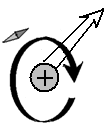
After all, here, too, there is a directed movement of the charge. A directional movement of charges is an electric current. If there is current, there should be a magnetic field around it.
A moving charge (or many charges — in the case of an electric current in a conductor) creates a “tunnel” around itself from a magnetic field. The walls of this "tunnel" are "denser" near the moving charge. The farther from a moving charge, the weaker the tension (“strength”) of the magnetic field created by it. The weaker the compass needle reacts to this field.
The pattern of distribution of the magnetic field strength around its source is the same as the pattern of distribution of the electric field around a charged body - it is inversely proportional to the square of the distance to the field source.
If a positively charged ball moves in a circle, then the rings of the magnetic fields that form around it as it moves are summed up, and we get a magnetic field directed perpendicular to the plane in which the charge moves:
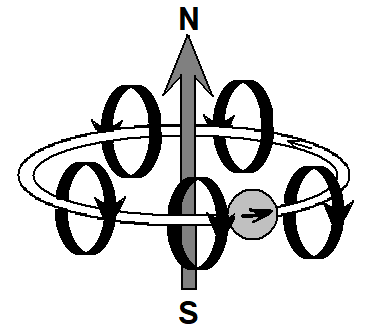
The magnetic “tunnel” around the charge turns out to be folded into a ring and resembles a torus (donut) in shape.
The same effect is obtained if the current conductor is rolled into a ring. A current conductor rolled into a multi-turn coil is called an electromagnet. Around the coil are the magnetic fields of the charged particles moving in it - electrons.
And if you rotate the charged ball around its axis, then it will have a magnetic field, like the Earth, directed along the axis of rotation. In this case, the current causing the appearance of the magnetic field is the circular movement of the charge around the axis of the ball - circular electric current.

Here, in fact, the same thing happens as when the ball moves in an annular orbit. Only the radius of this orbit is reduced to the radius of the ball itself.
All of the above is true for a negatively charged ball, but its magnetic field will be directed in the opposite direction.
This effect was discovered in the experiments of Rowland and Eichenwald. These gentlemen recorded magnetic fields near rotating charged disks: next to these disks the compass needle began to deflect. The directions of the magnetic fields, depending on the sign of the charge of the disks and the direction of their rotation, are shown in the figure:
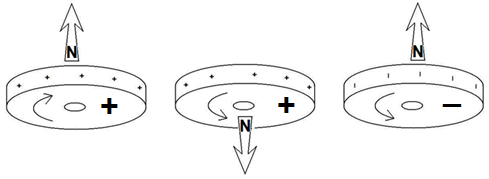
When rotating an uncharged disk, magnetic fields were not detected. There were no magnetic fields near stationary charged disks.
To remember the direction of the magnetic field of a moving positive charge, we will introduce ourselves in its place. Raise the right hand up, then point it to the right, then lower it down, then point to the left and return the hand to its original position - up. Then repeat this movement. Our hand describes the circles in a clockwise direction. Now start moving forward while continuing to rotate with your hand. The movement of our body is an analogue of the movement of a positive charge, and the rotation of the hand in a clockwise direction is an analogue of the magnetic field of a charge.
Now imagine that there is a thin and strong elastic web around us, similar to the strings of space that we painted, creating a model of the electric field.

When we move through this three-dimensional "web", due to the rotation of the hand, it deforms and moves clockwise, forming a kind of spiral, as if winding itself into a coil around a charge.
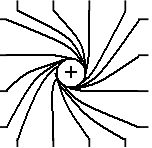
Behind, behind us, the "web" restores its correct structure. Something like this can be imagined as a magnetic field of a positive charge moving directly.
Now try not to move straight ahead, but in a circle, for example, turning to the left while walking, while rotating your hand clockwise. Imagine that you are moving through something that resembles jelly. Due to the rotation of your hand, inside the circle along which you are moving, the “jelly” will move upward, forming a hump above the center of the circle. And under the center of the circle, a cavity is formed due to the fact that part of the jelly has shifted up. So you can imagine the formation of the north (hump above) and south (hollow below) poles during the movement of a charge along a ring or its rotation.
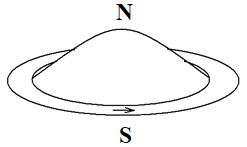
If you walk to the right when walking, then the “hump” (north pole) will form from below.
Similarly, we can form an idea of the magnetic field of a moving negative charge. Only rotate with your hand in the opposite direction - counterclockwise. Accordingly, the magnetic field will be directed in the opposite direction. Just each time, keep an eye on which side your hand pushes “jelly”.
Such a model clearly demonstrates why the north pole of one magnet is attracted to the south pole of another magnet: the "hump" of one of the magnets is drawn into the "cavity" of the second magnet.
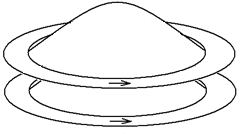
And this model also shows why there are no separate north and south poles of magnets, no matter how we cut them - the magnetic field is a vortex (closed) “deformation of space” around the trajectory of a moving charge.
An electron was found to have a magnetic field, such as it should have if it were a ball rotating around its axis. This magnetic field was called a spin (from English to spin - to spin).
In addition, the electron also has an orbital magnetic moment. After all, an electron not only “rotates”, but moves in an orbit around the nucleus of an atom. And the movement of a charged body generates a magnetic field. Since the electron is negatively charged, the magnetic field caused by its movement in the orbit will look like this:
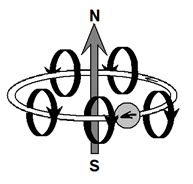
If the direction of the magnetic field caused by the motion of the electron in its orbit coincides with the direction of the magnetic field of the electron itself (its spin), these fields are added and amplified. If these magnetic fields are directed in different directions, they are subtracted and weaken each other.

In addition, the magnetic fields of other electrons of the atom can be added or subtracted from each other. This explains the presence or absence of magnetism (reaction to an external magnetic field or the presence of its own magnetic field) of some substances.
This article is an excerpt from a book about the basics of chemistry. The book itself is here:
sites.google.com/site/kontrudar13/himia
UPD: The material is intended primarily for middle school students. Perhaps Habr is not a place for such things, But where is the place? He is not here.
The source of any magnetic field is moving charged particles. And the directional movement of charged particles is called electric current. That is, any magnetic field is caused solely by electric current.
The direction of motion of positively charged particles is taken as the direction of electric current. If negative charges move, then the direction of the current is considered the opposite to the movement of such charges. Imagine water flowing through an annular pipe. But we will assume that a certain "current" in this case moves in the opposite direction. An electric current is denoted by the letter I.
In metals, current is generated by the movement of electrons - negatively charged particles. In the figure below, the electrons move along the conductor from right to left. But it is believed that the electric current is directed from left to right.

This happened because when they began to study electrical phenomena, it was not known which carriers most often carry current.
If we look at this conductor on the left side, so that the current goes "from us", then the magnetic field of this current will be directed around it clockwise.

If a compass is placed next to this conductor, then its arrow will rotate perpendicular to the conductor, parallel to the "magnetic field lines" - parallel to the black ring arrow in the figure.
If we take a ball having a positive charge (having a deficit of electrons) and throw it forward, then exactly the same ring magnetic field will appear around this ball, spinning clockwise around it.

After all, here, too, there is a directed movement of the charge. A directional movement of charges is an electric current. If there is current, there should be a magnetic field around it.
A moving charge (or many charges — in the case of an electric current in a conductor) creates a “tunnel” around itself from a magnetic field. The walls of this "tunnel" are "denser" near the moving charge. The farther from a moving charge, the weaker the tension (“strength”) of the magnetic field created by it. The weaker the compass needle reacts to this field.
The pattern of distribution of the magnetic field strength around its source is the same as the pattern of distribution of the electric field around a charged body - it is inversely proportional to the square of the distance to the field source.
If a positively charged ball moves in a circle, then the rings of the magnetic fields that form around it as it moves are summed up, and we get a magnetic field directed perpendicular to the plane in which the charge moves:

The magnetic “tunnel” around the charge turns out to be folded into a ring and resembles a torus (donut) in shape.
The same effect is obtained if the current conductor is rolled into a ring. A current conductor rolled into a multi-turn coil is called an electromagnet. Around the coil are the magnetic fields of the charged particles moving in it - electrons.
And if you rotate the charged ball around its axis, then it will have a magnetic field, like the Earth, directed along the axis of rotation. In this case, the current causing the appearance of the magnetic field is the circular movement of the charge around the axis of the ball - circular electric current.

Here, in fact, the same thing happens as when the ball moves in an annular orbit. Only the radius of this orbit is reduced to the radius of the ball itself.
All of the above is true for a negatively charged ball, but its magnetic field will be directed in the opposite direction.
This effect was discovered in the experiments of Rowland and Eichenwald. These gentlemen recorded magnetic fields near rotating charged disks: next to these disks the compass needle began to deflect. The directions of the magnetic fields, depending on the sign of the charge of the disks and the direction of their rotation, are shown in the figure:

When rotating an uncharged disk, magnetic fields were not detected. There were no magnetic fields near stationary charged disks.
Model of the magnetic field of a moving charge
To remember the direction of the magnetic field of a moving positive charge, we will introduce ourselves in its place. Raise the right hand up, then point it to the right, then lower it down, then point to the left and return the hand to its original position - up. Then repeat this movement. Our hand describes the circles in a clockwise direction. Now start moving forward while continuing to rotate with your hand. The movement of our body is an analogue of the movement of a positive charge, and the rotation of the hand in a clockwise direction is an analogue of the magnetic field of a charge.
Now imagine that there is a thin and strong elastic web around us, similar to the strings of space that we painted, creating a model of the electric field.

When we move through this three-dimensional "web", due to the rotation of the hand, it deforms and moves clockwise, forming a kind of spiral, as if winding itself into a coil around a charge.

Behind, behind us, the "web" restores its correct structure. Something like this can be imagined as a magnetic field of a positive charge moving directly.
Now try not to move straight ahead, but in a circle, for example, turning to the left while walking, while rotating your hand clockwise. Imagine that you are moving through something that resembles jelly. Due to the rotation of your hand, inside the circle along which you are moving, the “jelly” will move upward, forming a hump above the center of the circle. And under the center of the circle, a cavity is formed due to the fact that part of the jelly has shifted up. So you can imagine the formation of the north (hump above) and south (hollow below) poles during the movement of a charge along a ring or its rotation.

If you walk to the right when walking, then the “hump” (north pole) will form from below.
Similarly, we can form an idea of the magnetic field of a moving negative charge. Only rotate with your hand in the opposite direction - counterclockwise. Accordingly, the magnetic field will be directed in the opposite direction. Just each time, keep an eye on which side your hand pushes “jelly”.
Such a model clearly demonstrates why the north pole of one magnet is attracted to the south pole of another magnet: the "hump" of one of the magnets is drawn into the "cavity" of the second magnet.

And this model also shows why there are no separate north and south poles of magnets, no matter how we cut them - the magnetic field is a vortex (closed) “deformation of space” around the trajectory of a moving charge.
Spin
An electron was found to have a magnetic field, such as it should have if it were a ball rotating around its axis. This magnetic field was called a spin (from English to spin - to spin).
In addition, the electron also has an orbital magnetic moment. After all, an electron not only “rotates”, but moves in an orbit around the nucleus of an atom. And the movement of a charged body generates a magnetic field. Since the electron is negatively charged, the magnetic field caused by its movement in the orbit will look like this:

If the direction of the magnetic field caused by the motion of the electron in its orbit coincides with the direction of the magnetic field of the electron itself (its spin), these fields are added and amplified. If these magnetic fields are directed in different directions, they are subtracted and weaken each other.

In addition, the magnetic fields of other electrons of the atom can be added or subtracted from each other. This explains the presence or absence of magnetism (reaction to an external magnetic field or the presence of its own magnetic field) of some substances.
This article is an excerpt from a book about the basics of chemistry. The book itself is here:
sites.google.com/site/kontrudar13/himia
UPD: The material is intended primarily for middle school students. Perhaps Habr is not a place for such things, But where is the place? He is not here.
